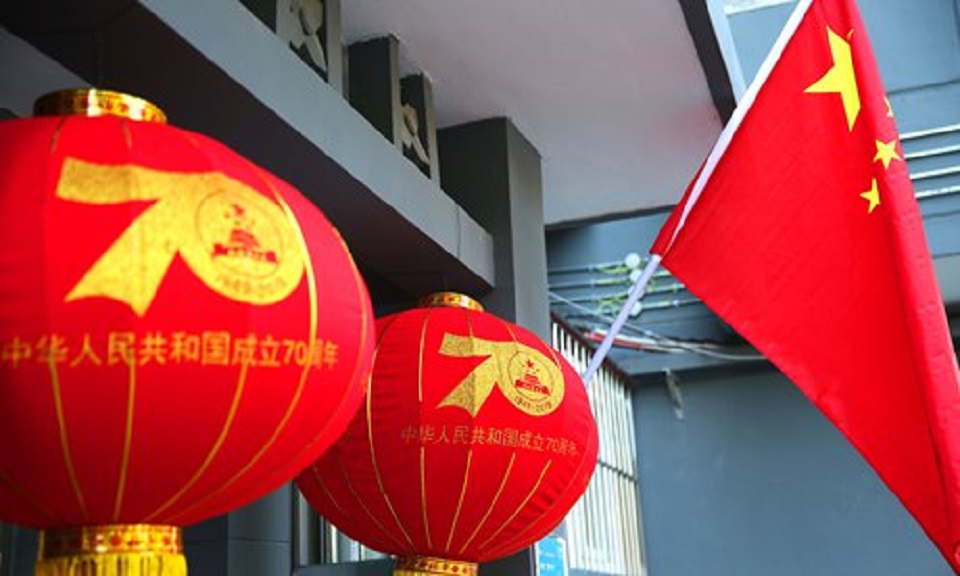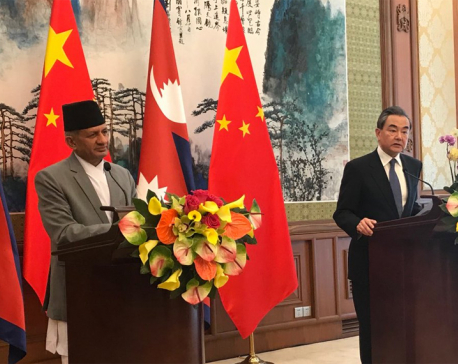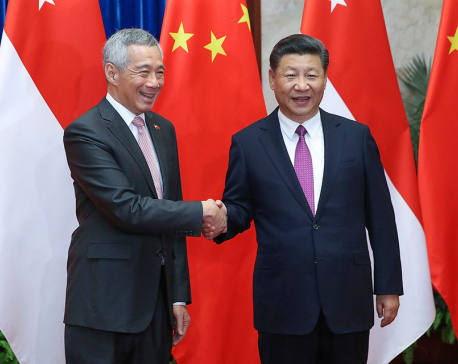
OR
Nepal is not playing China card
Published On: May 29, 2020 05:00 PM NPT By: Shiva Gautam, Ambika P Adhikari and Keshav Bhattarai


Shiva Gautam, Ambika P Adhikari and Keshav Bhattarai
Shiva Gautam is Professor at University of Florida, Ambika Adhikari is a Phoenix-based Urban Planner, and Keshav Bhattarai is Professor at University of Central Missourinews@myrepublica.com
More from Author
Nepal’s position on border is based on historical facts and legitimate national interest, not on any Chinese instigation. On more than one occasion, Nepal has actually pushed China in an awkward situation at the behest of India.
There are only a handful of countries which have close bilateral ties and open border as are existing between Nepal and India. However, the ongoing dispute around Limpiyadhura, Lipulekh and Kalapani along Nepal’s western border with India has aroused passionate discussions and sometimes unfriendly accusations in both India and Nepal. If not resolved amicably, this dispute has the potential to damage the enduring relationship between the two countries.
Background of dispute
The Sugauli treaty of 1816 signed by the representatives of the king of Nepal and British East India Company decrees that all lands east of the [Maha]Kali River belongs to Nepal. Subsequently, a map was created by the British India in 1827 showing Limpiayadhura as the source of Kali River with Gunji, Nabi, and Kuti villages within Nepal.
However, the subsequent maps produced by the Survey of British India between 1857 and 1881 show the border gradually shifting towards the east by naming the small tributary as the actual Kali River mentioned in the Sugauli treaty. These maps appear to misrepresent the location and origin of Kali River separating the two countries. According to the internationally accepted hydrological norms, when there are tributaries of a river, the main river is considered to be the one with the largest volume of water flow, the biggest river mouth, and the longest length. The Kali River identified by the Nepali authorities as the actual international boundary meets all these characteristics. In this light, some have called the attempt by the British India government and the succeeding Indian governments to alter the source of river as a “cartographic aggression” on Nepal.
The 1816 treaty was between the two enemy nations—Nepal and British East India Company—and was signed to end the hostilities between them. Subsequent treaties, agreements and understandings were executed between Nepal and British India after 1816, and after 1947, between Nepal and India, which have been even closer friends. There should be more good-will in these subsequent actions.
Allegation of China card
Some Indian leaders and media outlets accuse Nepal of playing a China Card on the border dispute, or that Nepal is being instigated by China. However, the allegations are just a convenient way to deflect the real issue. Let us review some examples on how the alleged China Card is untrue.
Nepal’s position about her border is based on historic facts and legitimate national interest, and not on any Chinese instigation. Contrary to playing a China Card with India, on more than one occasion, Nepal might have actually pushed China in an awkward situation at the behest of India. One of such incidents includes the permission by the government of Nepal in 1952 for the establishment of Indian military posts in the Nepali territories close to Nepal China border. This must have been an awkward situation for both Nepal and China. Such decisions were obviously not instigated by China, and do not represent Nepal playing a China Card.
Another incident is described in a book by the late Shriman Narayan, Indian ambassador to Nepal from 1964-67. When King Mahendra of Nepal approached India with his proposal to construct the East-West Highway along the southern border of Nepal, there was no response from India despite repeated requests. However, when King Mahendra reached out to China, the response was quick and affirmative. After learning of China’s nod to this request from Nepal, the erstwhile prime minister of India, Lal Bahadur Shashtri summoned Narayan and instructed him to ask Nepal to allow India help Nepal build the proposed highway. Nepal could not refuse the Indian request, and had to disappoint China on this issue and allow India to construct a part of the East West Highway. Nepal caused China an embarrassing situation.
India has imposed four blockades against Nepal, the last one in 2015. As Nepal is basically India-locked, when even basic items such as food, energy, medicine and other necessities become unavailable, Nepal has to seek other options in desperation. During the five-month long blockade of 2015, Nepal approached China for possible supply of energy, food and medical supplies through Nepal’s northern border with China. Compared with the convenient transit between India and Nepal, the northern routes have to pass through high mountains and the vehicles have to traverse the sparsely populated high plateau of Tibet, which is nine times as big as Nepal in area. Nepal would attempt market access through China only as a last resort.
Ignorance or arrogance?
India’s efforts to change the name of Kali River and the location of its origin through “cartographic aggression” seems to be a pattern of arrogance rather than ignorance. Further, propagating such geographically unsubstantiated information through media, and political, and military leaders is deeply disturbing.
When in 1970, Nepal wished not to allow foreign forces to use Nepali land against China and asked India to remove the eighteen military posts stationed along the Nepal-China border, India was not only reluctant, but also seemed offended. Finally, India withdrew all seventeen military posts stationed along the Nepal-China border except from the one based near Kalpani. India moved the post to Kalapani, a Nepali territory. India seems to have taken advantage of Kathmandu’s weak administrative reach to Kalapani during those years.
India also created an artificial location for the origin of Kali River by enlarging a small pond and collecting spring and rain waters near a temple built as the Kali temple at Kalapani. The Indian authorities have claimed this as the origin of the river Kali. This is an effort to obfuscate the location of Kali river’s mouth. This action is designed to help encroach a friendly nation’s territory. It is the misuse of Hindu Goddess Kali’s name.
Another example of how the Nepali people perceive actions by India as hegemonic happened during the 2008 flood in Nepal. Taking advantage of Nepal’s vulnerable situation, the government of India opened a temporary field office in Biratnagar to distribute reliefs to flood victims. India became reluctant to remove this temporary office even after completing the task and despite the repeated requests by Nepal’s two Prime Ministers Shushil Koirala and KP Oli. India established a commercial liaison office in Birgunj though there was no need for this.
Show big heart
India is the largest democracy, and has provided a big shoulder to many people who have escaped oppression and tyranny at home. It is an old civilization, and a birthplace of several great religious traditions. Its history as a place where Yoga and meditation originated is well established. India also showed to the world that the Gandhian practice of non-violence to gain legitimate rights of the people is an effective tool against oppressive rulers.
India rightfully feels glorious about amicably resolving several disputes along its borders through dialogues and without using military to settle its claim. In this light, the current push by India to gain a small piece of land that belongs to Nepal seems at odds with India’s moral ground.
India’s claim for Limpiyadhura, Lipulekh and Kalapani seems no different from Pakistan’s claim on Kashmir. King Hari Singh had signed the accession papers providing India a legitimate right on Kashmir. The accession was similar to the provisions of Sugauli Treaty establishing Nepal’s border on the West to Kali River. While the resolution of the current border dispute should be done through the diplomatic channels, India must help resolve this issue with an open mind and on the basis of the Sugauli treaty.
Shiva Gautam is Professor at University of Florida, Ambika Adhikari is a Phoenix-based Urban Planner, and Keshav Bhattarai is Professor at University of Central Missouri
You May Like This

In China, foreign minister Gyawali dreams to travel in China by modern train
BEIJING, April 18: Nepal is a natural area for cooperation between China and India, the Chinese government’s top diplomat State... Read More...

China protests US Navy sailing near South China Sea claims
BEIJING, Oct 11: China is protesting the sailing of a U.S. Navy ship near its territorial claims in the South China... Read More...










Just In
- NRB introduces cautiously flexible measures to address ongoing slowdown in various economic sectors
- Forced Covid-19 cremations: is it too late for redemption?
- NRB to provide collateral-free loans to foreign employment seekers
- NEB to publish Grade 12 results next week
- Body handover begins; Relatives remain dissatisfied with insurance, compensation amount
- NC defers its plan to join Koshi govt
- NRB to review microfinance loan interest rate
- 134 dead in floods and landslides since onset of monsoon this year








Leave A Comment